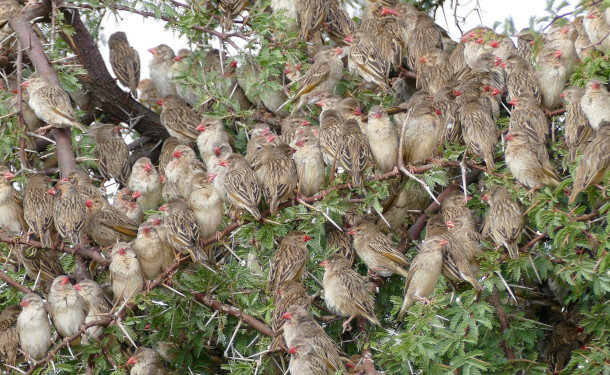BIRDNOTE®: The World's Most Abundant Bird
Air Date: Week of April 28, 2023

A flock of red-billed quelea perch in the branches of a tree. (Photo: Bernard Dupont, CC)
The red-billed Quelea is a small finch-like African bird that migrates long distances in massive flocks. BirdNote®’s Michael Stein reports.
Transcript
CURWOOD: The red-billed Quelea is a small finch-like African bird that migrates long distances in massive flocks. BirdNote’s Michael Stein has more.
BirdNote®
The World’s Most Abundant Bird
[Red-billed Quelea flock sounds, https://www.xeno-canto.org/389238 ]
In Africa, south of the Sahara, there’s a bird that roams the countryside in flocks—hordes, really—of two million or more. They fly in such tightly synchronized masses they can be mistaken at a distance for clouds of smoke.
[Red-billed Quelea flock sounds, https://www.xeno-canto.org/389238 ]
The birds are Red-billed Quelea. It’s estimated there are 1.5 billion of them — making them the most abundant of all wild birds.
[A few Red-billed Quelea singing, https://www.xeno-canto.org/373576 , 0.16-20 or more running behind narrative]
The sparrow-sized Red-billed Quelea, which is in the weaver family, has a stout, seed-cracking bill. The birds are mostly brown, but breeding males have red and black feathered heads.
Quelea nest in enormous colonies. A single tree may be hung with hundreds, even thousands, of carefully woven nests. Single colonies can cover hundreds of acres, totaling tens of millions of birds.
Unfortunately, their tastes include cultivated crops, like millet.
In fact, the increased planting of cereal crops over the last fifty years may have dramatically increased the number of quelea.
But setting aside their taste for crops, the sight of a couple million Red-billed Quelea swirling in unison and creating ever-changing patterns in the air is one of nature’s most amazing spectacles.
[flock sounds, https://macaulaylibrary.org/asset/88107]
###
Written by Bob Sundstrom
Producer: John Kessler
Managing Producer: Jason Saul
Associate Producer: Ellen Blackstone
© 2018 Tune In to Nature.org October 2018/2019 / March 2023
Narrator: Michael Stein
ID# REBIQU-01-2019-10-7 REBIQU-01
https://www.birdnote.org/listen/shows/worlds-most-abundant-bird
CURWOOD: For photos flock on over to the Living on Earth website, loe dot org.
Links
Living on Earth wants to hear from you!
Living on Earth
62 Calef Highway, Suite 212
Lee, NH 03861
Telephone: 617-287-4121
E-mail: comments@loe.org
Newsletter [Click here]
Donate to Living on Earth!
Living on Earth is an independent media program and relies entirely on contributions from listeners and institutions supporting public service. Please donate now to preserve an independent environmental voice.
NewsletterLiving on Earth offers a weekly delivery of the show's rundown to your mailbox. Sign up for our newsletter today!
 Sailors For The Sea: Be the change you want to sea.
Sailors For The Sea: Be the change you want to sea.
 The Grantham Foundation for the Protection of the Environment: Committed to protecting and improving the health of the global environment.
The Grantham Foundation for the Protection of the Environment: Committed to protecting and improving the health of the global environment.
 Contribute to Living on Earth and receive, as our gift to you, an archival print of one of Mark Seth Lender's extraordinary wildlife photographs. Follow the link to see Mark's current collection of photographs.
Contribute to Living on Earth and receive, as our gift to you, an archival print of one of Mark Seth Lender's extraordinary wildlife photographs. Follow the link to see Mark's current collection of photographs.
 Buy a signed copy of Mark Seth Lender's book Smeagull the Seagull & support Living on Earth
Buy a signed copy of Mark Seth Lender's book Smeagull the Seagull & support Living on Earth

